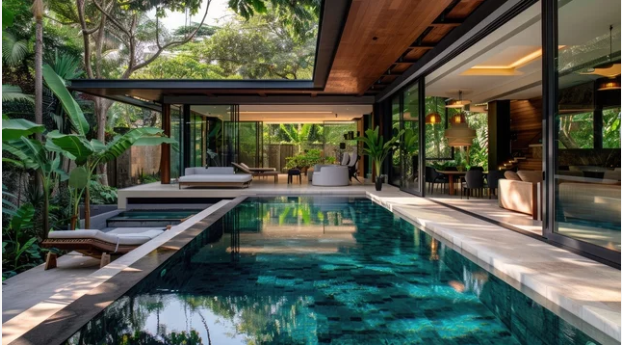Hotel amenities, from plush towels and luxury soaps to eco-friendly toiletries, are crafted using a wide variety of materials. The choice of materials not only impacts the quality and feel of these amenities but also influences sustainability and guest perception. In this article, we’ll explore the most common materials used in the production of hotel amenities, the reasons behind their selection, and the environmental considerations that shape these choices.

1. Fabrics for Linens and Textiles
Linens and textiles, such as sheets, towels, and bathrobes, play a significant role in the comfort and luxury of a hotel stay. The most common materials used include:
- Cotton: Renowned for its softness and breathability, cotton is a popular choice for bed linens and towels. High-quality Egyptian or Pima cotton is often used in luxury hotels for its finer fibers, creating softer and more durable products.
- Microfiber: This synthetic material is lightweight and quick-drying, making it a practical choice for towels and bathrobes. While not as luxurious as cotton, microfiber is cost-effective and easy to maintain.
- Bamboo Fiber: Bamboo-based textiles are eco-friendly and naturally antibacterial. Towels and sheets made from bamboo fibers are soft, absorbent, and considered sustainable since bamboo grows rapidly without the need for pesticides.
- Linen: This natural fiber is derived from flax plants and is valued for its breathability and moisture-wicking properties. It’s used in luxury settings for its sophisticated texture and durability, although it can be pricier than cotton.
The choice of fabric depends on the hotel’s budget, the desired level of luxury, and environmental considerations.
2. Ingredients in Personal Care Products
The toiletries provided in hotel rooms—such as shampoos, conditioners, body washes, and lotions—are composed of a mix of natural and synthetic materials. The most common ingredients include:
- Essential Oils: To create pleasant, natural fragrances, essential oils like lavender, eucalyptus, and tea tree are often used. These oils can also have soothing or invigorating properties, adding to the guest experience.
- Plant-Based Extracts: Ingredients like aloe vera, chamomile, and coconut oil are included for their moisturizing and skin-friendly qualities.
- Sulfate-Free Surfactants: With growing awareness of potentially harsh chemicals, many hotels are opting for sulfate-free cleansing agents to make their personal care items gentler on the skin and hair.
- Natural Preservatives: To extend shelf life without using artificial chemicals, natural preservatives such as vitamin E (tocopherol) and rosemary extract are increasingly common.
Many high-end or eco-conscious hotels emphasize using products with all-natural, organic ingredients, which align with trends toward healthier and more sustainable living.
3. Materials for Packaging
The packaging of hotel amenities also plays a critical role in both functionality and branding. Common materials include:
- Plastic: Traditional packaging for shampoos, conditioners, and lotions often involves plastic bottles or sachets. However, single-use plastics are declining due to environmental concerns.
- Biodegradable Materials: Eco-friendly hotels frequently use biodegradable or compostable packaging made from materials like cornstarch or cellulose.
- Recycled Paper and Cardboard: For items such as soap wrappers or product boxes, recycled paper is a sustainable choice that helps reduce the carbon footprint.
- Glass: Higher-end hotels may use glass bottles for toiletries, providing a more premium feel and a reusable packaging option.
The trend is shifting toward sustainable packaging, as guests increasingly prioritize eco-friendly practices.
4. Advanced Materials for Tech Amenities
Hotels that offer tech-based amenities often use materials designed for durability and modern aesthetics:
- Tempered Glass: Often used for touchscreens, mirrors with embedded technology, and smart room controls, tempered glass is scratch-resistant and provides a sleek, modern look.
- High-Grade Plastics and Polymers: These materials are used for devices like digital alarm clocks, charging stations, and thermostats. They offer durability and flexibility for design customization.
- Stainless Steel and Aluminum: Found in amenities like hairdryers and in-room safes, these metals are durable and give off a contemporary feel.
These materials are chosen for their ability to withstand frequent use and maintain aesthetic appeal.
5. Eco-Friendly Alternatives and Sustainability
Sustainability is becoming a major focus for the hospitality industry. Hotels are exploring alternative materials to minimize their environmental impact:
- Biodegradable Soaps and Shampoos: Formulated with natural ingredients and free from synthetic chemicals, biodegradable toiletries break down safely without harming ecosystems.
- Bamboo and Reusable Materials: Bamboo combs, toothbrushes, and dispensers for toiletries are popular in eco-conscious establishments.
- Refillable Dispensers: Instead of individual mini-bottles, many hotels are adopting larger, refillable dispensers to cut down on plastic waste.
These shifts not only align with global sustainability efforts but also resonate with guests who prioritize eco-friendly practices when choosing accommodations.

FAQs
What materials are commonly used for hotel towels and linens? Hotel towels and linens are typically made from cotton, microfiber, or bamboo fiber. High-end hotels may use Egyptian cotton for added luxury and durability.
Are hotel toiletries made with natural ingredients? Many modern hotels use toiletries that feature natural ingredients such as essential oils, aloe vera, and plant-based extracts. This trend is driven by a demand for healthier, eco-friendly products.
What packaging materials are used for eco-friendly hotel amenities? Eco-friendly hotel amenities are often packaged in biodegradable materials, recycled paper, or glass. These choices reduce waste and align with sustainability goals.
How do luxury hotels differentiate their amenities? Luxury hotels often use exclusive, high-quality materials like Egyptian cotton for linens and bespoke formulations with natural extracts for toiletries. Packaging may involve glass bottles or custom designs that enhance the brand image.
What materials are used for tech-based hotel amenities? Tech-based amenities in hotels may use tempered glass for touchscreens, high-grade plastics for durability, and metals like stainless steel for premium devices such as in-room safes or smart thermostats.
Why are eco-friendly materials important in hotel amenities? Eco-friendly materials help reduce the environmental impact of hotel operations, appeal to environmentally conscious guests, and align with global sustainability initiatives.
